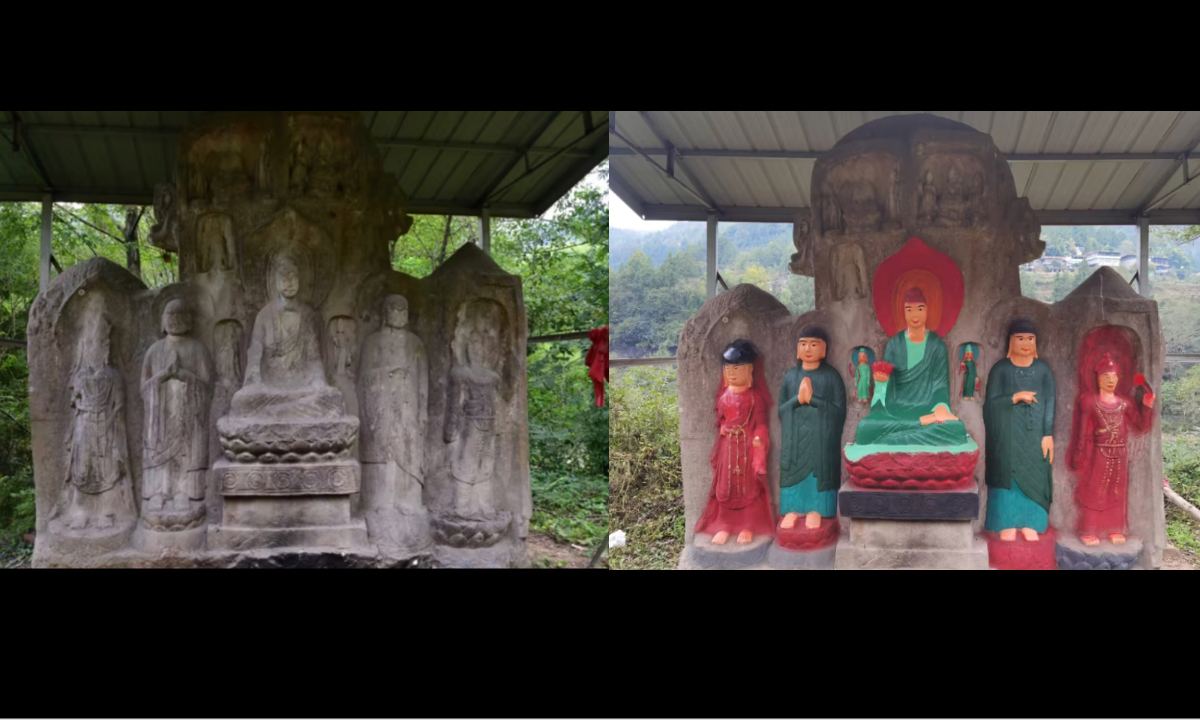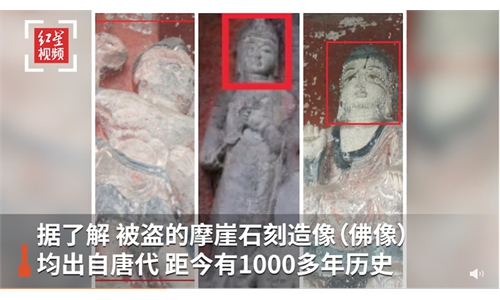Buddha statues created 1,400 years ago in SW China’s Sichuan damaged with colorful paints by local worshipper villagers

Before and after the painting of Buddha statues created in the late Northern Wei (386-534) during the Northern and Southern Dynasties (386-589) in Bazhong city, Southwest China’s Sichuan Province Photo: Sina Weibo
A set of Buddha statues created 1,400 years ago in Bazhong city, Southwest China’s Sichuan Province, was damaged with colorful paints by local worshipper villagers who expected to “redeem a wish to the god” with “make-up.” Experts have been invited by local authorities to restore the cultural relics.
The Shifeihe Buddha statues carved on the precipices in rural Nanjiang County in Sichuan were created in late Northern Wei period (386-534) during the Northern and Southern Dynasties (386-589), and are of great academic significance to the study of Bazhong and Sichuan grotto statues and the exchanges of the Buddhist culture and art.
Some netizens on Monday exposed online that the Buddha statues were painted with colors.
According to the local cultural relic protection department, the set of Buddha statues was just discovered in 2021 and has not been registered with the cultural relic protection department. Although they are monitored with surveillance cameras and protected with shelter, the authority failed to stop the villagers’ damaging behavior to the Buddha statues in time due to their remote location in the mountains, Shangyou News reported on Tuesday. After the incident happened, relevant experts have been invited to examine the damages and restore the statues.
According to a joint research by Bazhong City Cultural Relics Bureau, the College of History and Culture (Tourism), Xi’an Beilin Museum and the cultural relics protection research center in Nanjiang County, this set of Buddha statues on the precipices were created in late Northern Wei and they were continued to be carved in Tang Dynasty (618–907), with a complicated process of formation. Besides, its characteristic of being carved on the surface of natural stone is the only example in Sichuan area.
These characteristics have very significant academic values in improving the study in the development of grottos in Sichuan and reveal the exchanges of Buddhist culture and art between Sichuan and the northern central plains, according to the research.
According to the employees from the local cultural relic protection bureau, those who painted the Buddha statues were some elderly villagers in their 70s and 80s who can hardly be punished but can only be educated. The elderly believe that they did good deeds to the Buddha.
The paints they used to color the statues were acrylic paints and relevant experts have been invited to examine if the statues can be restored.
In recent years, there have been several incidents of precious Buddha statues being covered with paints. In August of 2018, the Buddha statues in Fengmen Temple in Ziyang city, Sichuan, were painted with oil paints and mended with cement, which sparked heated discussions.
The Sichuan Provincial Cultural Heritage Administration found that 13 sites of Buddha statues were colored with paints, most of which happened in the 1980s and 1990s.
Such cases happened in multiple places including Guang’an, Ziyang and Neijiang in Sichuan.
China’s Cultural Relics Protection Law stipulates that the renovation of a cultural relics protection unit shall be reported to the corresponding administrative department for approval according to its level. The renovation, relocation and reconstruction of a cultural relics protection unit shall be carried out by the unit that has obtained the qualification certificate for cultural relics protection projects.
Global Times

